AuthorLyn Chimera is a Master Gardener, consultant and lecturer. Archives
May 2023
Categories |
Back to Blog
Ground Cover Beyond Pachysandra3/4/2023 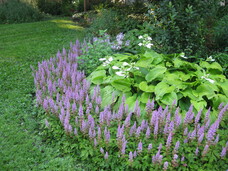 By: Lyn Chimera Plants to cover bare soil have long been a staple of any garden. Basically, any plant that covers the ground can be used as groundcover. It doesn’t have to be low growing. Groundcover provides all sorts of benefits to a garden including less weeding, protection from soil erosion, reduction of water evaporation, softening edges, and protection of perennials from harsh winter temperature fluctuations. In addition to these benefits, ground cover is also good for the environment. By replacing some lawn with ground cover, you greatly reduce watering needs and use of herbicides along while creating a better habitat for beneficial insects. Ground covers also act as a living mulch to improve soil. Ground covers can be a beautiful addition to any garden by adding interest, texture, and beauty. Pachysandra, myrtle, and ivy are the most common ground covers in our area but there are so many other options. The following are some suggestions for a variety of growing conditions. They are all deer resistant. Bugle weed (Ajuga) is a fast spreading, low growing plant for sun to shade that has a lovely purple to lavender upright bloom in the spring. It comes in a variety of foliage colors from “chocolate” to variegated. Ajuga is a good choice for an area all its own. It is an aggressive spreader once established and not a good choice for between other perennials. It also works well in blooming or bee lawns. Wild Ginger (Asarum canadense) is an outstanding shade native for hard to grow sites. It forms dense cover with somewhat large attractive heart shaped leaves about 8-10 inches high. I have a wonderful patch under a giant Norway spruce where absolutely nothing else would grow. Better used around a tree than interspersed with other pants. Spreads well when established and would overtake a perennial bed. Astilbe is a shade loving flowering plant that comes in a variety of sizes and color of bloom. Astilbe chinensis, has low growing foliage, 6 – 8 inches, with a spike of lavender bloom in late summer when not much is blooming. It makes a great dense ground cover for the front of a border. Also makes a good lawn replacement plant. Taller varieties are good ground cover for mid to back of a bed. (see photo) Gold Star (Chrysogonum virginianum) is an excellent native ground cover for sun to shade. It has deep green textured leaves with lovely yellow blooms in spring with a smaller rebloom in late summer. The whole plant stays low even in bloom. An aggressive grower that will quickly cover an area. Japanese Painted Fern (Athyrium niponicum) makes a lovely color and texture addition to any shade garden. It is lower growing than many ferns (about 12-16 inches) and has graceful arched fronds as opposed to the upright fronds on many ferns. The Japanese painted fern comes in a variety of color combinations including silver, burgundy and cream. It is not aggressive so can be used among other shade perennials. Prefers moist soil. Bishop’s hat (Epimedium) comes in a variety of sized from 6 - 18 inches tall. The various varieties come in many colors including, white, pink, rose and yellow. It’s a perfect plant for dry shade. Epimedium blooms in spring before the leaves come up. The leaves are heart shaped, some with burgundy edges that turn all burgundy in the fall and persist during winter. Not an aggressive spreader. Moss There are many varieties of moss that do well in moist, acidic shade. Once established it is a beautiful ground cover. It does need moisture so would need to be irrigated during dry periods. Many people try to remove moss growing in their yards. It’s nature’s way of telling you that’s what wants to grow there so relax and enjoy it! Moss gardening is one of the newest trends in Horticulture. Lungwort (Pulmonaria) is a lovely spring blooming perennial that comes in a variety of bloom colors. The mottled leaves add great visual interest. It grows well in shaded areas and is not aggressive so won’t take over. Dwarf comfrey (Symphytum grandiflorum) is a real work horse. It’s low growing deep green leaves cover ground quickly. It will do well in part sun or shade and has lovely bell like blossoms in spring. It will even bloom in dense shade under a maple but not as vigorously as when it gets a little more sun. This plant is slow to establish but spreads well once it does. The plants above are just a sampling of the possibilities. With any plant you are considering, make sure it matches your growing conditions and check on its rate of spread. Many ground covers can be very aggressive which is desirable under certain conditions but not others. Master Gardener Education Day:Saturday, March 11 Classics V Banquet Center Niagara Falls Blvd. Three Excellent speakers: Tim Boebel, Gardening with Flowering Shrubs in the North Tim has published two books on hydrangeas--Hydrangeas in the North (2011) and Today’s Hydrangeas (2019). Paul Zammit, Container Gardening: Drama for Every Season A professor at Niagara College in Ontario and past Director of Horticulture at the Toronto Botanical Gardens. Allison Morrill Chatrchyan: How Climate Change is Affecting Our Gardening Allison is Senior Research Associate in the Department of Earth & Atmospheric Services in the College of Agriculture and Life Sciences at Cornell University. Time: 8:30 – 3:00 Cost $60 includes Continental breakfast, hot buffet lunch and basket raffle To register go to: erie.cce.cornell.edu/events or call 716-652-5400 ext. 176
0 Comments
Read More
Back to Blog
Give the Gift of a Book12/1/2022 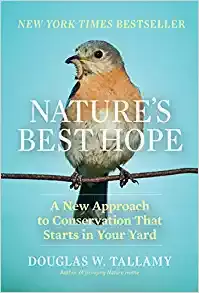 By: Lyn Chimera Many of us are trying to decide what to buy for friends and family over the holidays. A book is always appreciated and often something people don’t buy for themselves. On the subject of gardening there are books on any topic you can imagine from trees to improving soil and everything in between. The following are some recommendations. The Living Landscape, by Doug Tallamy and Rick Darke is subtitled Designing for Beauty and Biodiversity in the Home Garden. Gardeners who want a landscape that supports nature and is beautiful at the same time will love this book. By combining the insights of two outstanding authors, this book offers a model that anyone can follow. The book outlines the strategies for making and maintaining a diverse, layered landscape from ground level to trees. The book includes providing for outdoor rooms, areas for children and pets, incorporates fragrance and edible plants all while providing cover, shelter and sustenance for wildlife. On top of all the excellent information the book is filled with beautiful photographs by Rick Dark who has won awards for his photography. This can be a coffee table book as well as an informational one. One of the most useful sections is at the end where they list plants by region showing growing needs and what they help in nature. Doug Tallamy had changed the conversation about the importance of home landscaping in supporting pollinators, birds and the plants and insects they need to survive. His book Bringing Nature Home is a must read as it describes the relationship between what you plant and how it matters to nature. It also includes an extensive section showing which plants support butterflies and moths as well as a regional listing of natives that have a benefit for wildlife. His second book Nature’s Best Hope covers a new approach to conservation that begins in our yards. He calls it “Homegrown National Parks”. His message is you don’t have to plant all natives but if everyone planted some the overall effect would be so beneficial to nature, beneficial insects and birds. The decline in honeybees has been in the news for years. The book Honeybee Democracy, by Thomas Seeley will give you an insightful look at the complex life of honeybees. Based on scientific studies, Seeley has written a very good and readable book about how bees operate and function as a group. We have a lot to learn from their “democratic” methods of decision making. You will never look at honeybees in the same way again. If you’re looking for a general how to book on gardening, The Well-Tended Perennial Garden, by Tracy DiSabato-Aust is excellent. This is one of the most useful and practical books for gardeners at all levels. There are chapters on basic perennial garden planning and maintenance, pruning and an encyclopedia of perennials that includes information on how to grow and maintain each plant. The appendix includes a perennial maintenance manual and listings of month-by-month maintenance suggestions. This book also includes lots of time and work saving techniques. It’s a go to book for basic and advanced perennial gardeners. If a book that gives detailed information on selected plants is what you’re looking for, Spring Wildflowers of the North East and Summer Wildflowers of the North East, by Carol Gracie would be perfect. In addition to the most amazing photographs these books educate the reader about each plant, its history, uses, propagation and growing conditions along with interesting facts. There aren’t just a few paragraphs about each plant but multiple pages. Even advanced gardeners will learn from these books. Anyone interested in trees would enjoy Finding the Mother Tree, Discovering the Wisdom of the Forest, by Suzanne Simard. This book is basically a story about her journey into the life of trees and coming to understand how they function. Simard brings us to the intimate world of trees, in which she brilliantly shows us that trees are not simply the source or timber or pulp but are a complicated circle of life. Trees in a healthy forest support each other and even communicate through underground networks. It’s fascinating and reads like a novel. There are so many books available about gardening and nature that you’re sure to find just the right gift – for yourself or others.
Back to Blog
Gardening is Good for You!10/2/2022 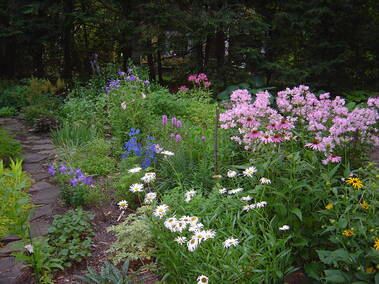 By: Lyn Chimera There are so many reasons that gardening is good for you. Recently I was invited to give a presentation on the topic, and the research I did made me realize just how very many ways there are. Not only do you get beautiful flowers and/or yummy vegetables it’s great for your physical and mental wellbeing. For me, gardening helps keep me centered. It’s very relaxing while at the same time it can be hard work which helps work out stress and frustrations. While gardening you focus on what you’re doing and forget about what’s bothering you. Even weeding can almost be meditative and it sure is satisfying once you’re finished. Another benefit is that inhaling a naturally occurring bacteria in the soil M.vaccae, can release serotonin which reduces anxiety. Besides relieving stress, gardening is good for you in other ways. It helps build strength and flexibility. Hand strength improves from using pruners, a trowel, shovels, gripping any tools, wheelbarrow handles etc.. It’s hard to do any gardening without using your hands. Your back gets lots of exercise from bending and lifting for all sorts of chores which really helps strengthen those muscles. When my back gets a little tired from all that bending, I stand up and flex my spine back like a mini backbend then do a yoga move called scrape the barrel where you rotate your hips as if you were scraping the inside of a barrel. Both these stretches help relieve back strain and help avoid a sore back. Gardening also makes you stronger. Hauling watering cans, hoses, digging, and all garden chores improve strength. Gardening is an excellent low impact exercise. Studies have shown that people stick with gardening much more than they stick to going to a gym and you don’t have a monthly fee! General gardening can burn 330 calories per hour. It would be more for more strenuous garden work like mowing (not a riding mower), digging, raking etc.. While outside gardening you are exposed to vitamin D through sunshine. Vitamin D helps increase calcium and makes bone stronger. It also boosts your immune system. However, don’t forget to use sunscreen. Another benefit of gardening is it gets you outside and away from electronics and screens. This relieves eye strain and gives your brain a rest. Try trading your blackberry for blackberry bushes! Growing fruits and vegetables dramatically improves your diet. Fresh produce is much more nutritious and healthier for you. You can control and hopefully eliminate the pesticide and herbicide use. Besides it tastes much better. People who grow vegetables tend to include more vegetables in their diet which is another benefit to your health. Children involved with growing food are much more willing to try things and will eat vegetables they might not ordinarily. If you happen to have back and or knee problems, you can still enjoy gardening. Raised beds, some can be as tall as tables, allow you to garden with little to no bending. Planters and even window boxes can be used to grow food or flowers. Knee pads or movable foam pads are very helpful for sore knees. I’ve used both and preferred knee pads that wrap around your knees. That way you don’t have to move the foam pad from place to place. Bench seats are also available. Some are 2-sided, one side for a kneeling pad and when it's turned over it becomes a raised seat. The legs form a bar for helping you get up. Therapeutic gardens have been used for centuries. The original Richardson Complex on Elmwood Ave in Buffalo was an asylum for people with mental problems. Working outside in vegetable and flower gardens was part of everyone’s therapy. Many prisons have gardens where prisoners can learn skills that could be turned into employment once released. These gardens also help calm prisoners and generally improve their behavior. My mother was in a nursing home where they had a courtyard garden which gave her hours of pleasure. She didn’t remember a lot but once in the garden she knew what to do. It was amazing to watch. Don’t worry if you have no access to a garden, just being outside in nature can improve your mood, health, and wellbeing. So let nature help you relax and enjoy nature’s beauty.
Back to Blog
July is for Visiting Gardens7/11/2022  By: Lyn Chimera For those of you, like myself, who have been waiting all winter for July when we can visit some of the best gardens in the country, the wait is over. The month of July in Western New Yok is all about gardens and gardening. The gardening events begin in June with the Lewiston Gardenfest, 6/18&19 and The Buffalo Style Garden Art Sale at the Botanical Gardens 6/25&26. However, it’s the month of July that is packed full of garden visit opportunities. The best way to learn about all the events is to get the booklet, Open Gardens, published by Gardens Buffalo Niagara. It is available at many nurseries and the low cost of $10. Check out their website for full details: https://www.gardensbuffaloniagara.com/ There are three major opportunities for visiting local gardens during July: Open Gardens The advantage of Open Gardens is you don’t have the crowds to deal with like during Garden Walk Buffalo and parking is not an issue. There are over 100 private gardens open to the public on Thursdays and Fridays from July 7th through the 29th covering Erie and Niagara Counties. Some are open both days, some all of one of the days and others part of one of the days. There are even some gardens open at night. All are free. The gardens are divided into 9 geographic sections such as Northtowns East and West, Buffalo and Southtowns Bouquet. The Open Gardens booklet has complete listings including maps and information about the gardens and points of interest in the area. Unfortunately my gardens will not be on this year. Community Garden Walks Fourteen local communities are sponsoring neighborhood Garden Walks during four weekends in July beginning July 9th. The Open Garden book or their website tells which areas like Hamburg, Lancaster and Grand Island are open when and where to get the maps. Each community puts out their own map with directions and descriptions of the gardens. The tours are self-guided. Most are free but some ask for a donation. This is a lovely way to spend a day or afternoon getting to know a community. Garden Walk Buffalo July 30 & 31, 10 AM – 4 PM. This is the highlight and biggest draw of the month. The Buffalo Garden walk has evolved into the largest garden tour in America. Tens of thousands of people come from all across the country to see our amazing gardens. It has become the garden event of the year written up in national gardening magazines. There are hundreds of private and public gardens throughout the city open on these 2 days. Maps are available at various locations and at the Garden Walk website. www.gardensbuffaloniagara.com/garden-walk-buffalo Some tips for any of the garden visits:
Wear comfortable shoes and dress for the weather. Some gardens have stone walkways, paths with roots or other difficult walking situations. Also, grass may be wet and slippery. The gardens are open rain or shine so plan to dress appropriately. Take your camera/cell phone to take pictures. After seeing many gardens you’ll want to remember some of the pants you liked, landscaping ideas, garden art etc. Trust me, after seeing 8-10 gardens it’s hard to remember where you saw what or what it was. Don’t be hesitant to talk to the owners and ask questions. You’ll be seeing some plants you might not recognize or wonder how much work is involved in their garden, how long did it take to develop, helpful tips etc.. Be mindful of people’s property and stay on paths or designated areas. It’s easy to be distracted by a beautiful plant or whatever and step where you shouldn’t. Your garden touring experience will be much more enjoyable if you plan a strategy. Get the Open Gardens booklet or download maps from the website to plan your route. Don’t forget to plan a lunch break or shopping jaunt. It’s a delightful way to spend a day with like minded gardening fiends. I guarantee you will get some good ideas. Hope to see you soon!
Back to Blog
Thoughts on Spring Improvements3/31/2022 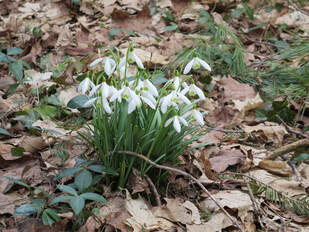 Thoughts on Spring Improvements By: Lyn Chimera Who doesn’t look forward to spring? It’s not just because it means the cold and snowy weather of winter is behind us. Spring’s reawakening is natures promise that life goes on. How wonderful it will be to see the first daffodils and crocus. Spring is the season for optimism. To me spring is almost like the New Year, time to make resolutions for improvement in my gardens. Lots of us are planning what to add, remove or change. There is so much in the news about pollinator, songbird, and insect decline along with climate change why not make improvements this spring that can help alleviate these problems. I recently attended the annual Ithaca Native Landscaping Symposium (via Zoom). The major focus of the Symposium was what the average homeowner can do to help support not just pollinators but other beneficial insects, birds, and nature in general. The number one thing you can do is stop using insecticides/pesticides. First, there is no insecticide that only kills the bad guys. Any insect that eats that pant or gathers its pollen or nectar will be affected. Since over 90% of the insects in our gardens are beneficial just the thought of killing all insects is counterproductive. Beneficial insects not only pollinate but help control harmful insects by eating or parasitizing them. Since I stopped using pesticides, at least 30 years ago, my gardens are a buzz with beneficials, and I have very little problem with the bad guys. When the Japanese beetles arrive, I knock them into soapy water and that really helps. Improving soil is the key to healthy plants. Chemical fertilizers, the ones you mix in water, may feed the plants but are harmful for the soil. People don’t realize it, but healthy soil is full of life from worms and bugs you can see to billions of microscopic creatures you can’t see. It’s the soil life, its decomposition and excrements, that provide nutrients for plants. Think about it…no one “feeds” the soil in the meadows and woods and those plants grow very well. So, what can you do? Add organic matter instead of chemical fertilizers. Compost is the best way to improve your soil’s nutrition and texture. Compost is filled with microbial life which will inoculate your soil. It’s easy to add a little to every planting hole. About 1/3 compost with 2/3 of the existing soil is a good ratio. Compost can also be used as a mulch. It’s not necessary to work it into the soil. Simply leave it on the top as a mulch would be and nature will take care of distributing the nutrients. Compost is the best thig to add to clay soil. In fact, there is nothing in your gardens that can’t be helped by using compost. When the plants are healthier, they are more resistant to insect and disease problems. You can make your own compost or purchase it bagged or by the yard from local nurseries. If purchasing bags read the ingredients and make sure it doesn’t contain topsoil or anything else as filler. When purchasing from a nursery ask about the ingredients. Compost should never be smelly. If it is, don’t buy it. Leaves are another excellent soil amendment. After a few years of using compost as mulch I now just use mulched leaves that I gather in the fall. It’s the best mulch and it’s FREE! Another important thing you can do to support nature is plant native plants. The connection between plants that evolved in our area to the beneficial insects, birds and animals that also evolved here is crucial for a productive habitat. Not only do native pants provide pollinators with the nectar they need they serve as host plants for the larva of beneficial insects including butterflies. Don’t think you have to rip out your nonnative plants and start over. If you need a plant for a spot or are replacing one that died, look for a native that’s right for that site. Here comes the tricky part. Most “natives” found in nurseries have been hybridized for color, size, or other features to please gardeners. Often, they no longer provide the food native insects and birds need because they are sterile. When buying a native look up the botanical name and ask for that. If there is a common name after the botanical name that means, it’s a cultivar. There are nurseries that sell the true species so ask for them. The more people request the true species the more nurseries will carry them. If you have trouble finding a plant, check online but always try local independent nurseries first. Happy Gardening!
Back to Blog
February 27th, 20222/27/2022 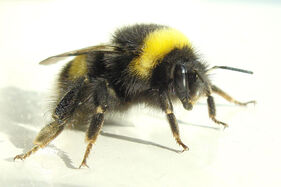 The Amazing Bumblebee By Lyn Chimera Recently I was asked to compile some interesting information about bumblebees, in the genus Bombus, for an informational flyer Master Gardeners could use as a handout at various events like Plantasia (March, 16-20). They are such fascinating little critters I wanted to share some of what I learned. First of all, Bumblebees are large (about an inch) yellow and black flying insects native to the US. They have 4 wings. The two rear wings are smaller than the front wings and the wings beat at a rate of 130-240 beats per second. There are about 46 varieties of bumblebees in N America and over 250 known varieties worldwide. Bumblebees are our only native bee that lives in colonies. They prefer to live in cavities like dead trees and abandoned nests. Their favorite nesting site, however, is an abandoned rodent tunnel because it’s warm and already lined with fur. Sounds cozy to me. Their colonies range in number from 50 to 500. Bumblebees only live for one year. In the fall new queens are hatched and spend the winter in a protected area then start new colonies in the spring. Because the bumblebees don’t overwinter, they don’t need to store food. The nectar and pollen they gather goes to feed themselves and their young. As pollinators go bumblers are much more efficient than honeybees. This is due in part to their hairy bodies which spread the pollen more effectively. They also “buzz pollinate” which means they vibrate their bodies as they come in contact with a flower to cause even more pollen distribution. One of the most interesting facts about their pollination is they leave a scent marking on each flower they pollinate. This alerts other bumblers that the flower had been pollinated so go on to another. How efficient! The reason they are so favored by agriculture and nature is that they are generalists rather than specialists. Bumblers will gather from a variety of species at the same time. In addition, due to their built in “fur coat” they can fly and pollinate earlier in the spring and later in the fall than many other pollinating insects. They also have an amazing tongue that is often longer than a honeybee’s so they can get nectar from a wider variety of flowers. By the way their tongue is also their sense organ for taste and smell. Worker bumblebees have the job of gathering nectar for carbohydrates and pollen for protein. They are real workhorses flying a mile or further to gather food. The average worker carries 25% of their body weight in pollen and nectar. Some have been measured to carry 75% of their body weight. That would be like a 150 pound person carrying 37.5 lbs. or up to 122 lbs.! Now that’s impressive. I must admit I love watching bumblebees in my garden. They won’t sting unless threatened so are safe to watch form close up. Often you will find one in the early morning sleeping on a flower. Honeybees will do this as well. In my garden native turtle head (Chelone obliqua) is one of their favorite flowers. Because of the shape of the flower the bumbler has to wiggle its way into the petals to get to the pollen and nectar. Always entertaining to watch. What can you do to help protect bumblebees and basically all pollinators? Plant a variety of native and pollinator attracting flowers covering a span of seasons and encourage neighbors to do the same. Destruction of habitat is one of the contributing factors in the demise of bumblebees. Avoid using pesticides particularly the systematic ones that persist throughout the plant. These toxins effect the whole plant including the pollen and nectar and kill all insects including pollinators. Not using pesticides and herbicides is one of the best ways any home gardener can help the ecology. Never harm a bumblebee; they are our friends.
Back to Blog
Christmas Cactus1/3/2022 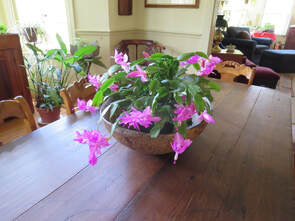 By: Lyn Chimera Christmas cactus(Schlumbergera buckleyi)is a very popular gift plant during the holidays. It’s the gift that keeps on giving as it makes an easy to care for house plant that will give years of pleasure and beautiful blooms. This year I was given one at Thanksgiving which had more blooms and buds than I had ever seen. Usually there are 1 or maybe 2 blooms per stem but this one had up to FIVE! One bloom and the rest buds. After the first bloom flush faded there was a second flush but after that the remaining buds just dropped off. Obviously, this was an unusual Christmas cactus, so I decided to do a little research. What an amazingly interesting plant! Most of the plants sold in stores today are hybrids of S. russelliana and S. truncata. The hybrid type determines when it will bloom. There are over 200 cultivars of these plants which give a variety of flower colors. The other shocker was they aren’t desert cactus at all, originating in the rain forests of Brazil. They typically grow in trees like epiphytes. Who knew? Since they don’t naturally grow in arid conditions they do need to be watered, but not too much. The two most common varieties are Christmas and Thanksgiving cactus. Thanksgiving cactus is described as having leaves shaped like crab claws with two to four pointy serrated segments on each side (which mine has). The end of each segment is slightly concave. The leaves of Christmas cactus have a more rounded, scalloped edge with a slightly curved end. Both have similar flowers that mostly bloom from the end but sometimes from a leaf join. The flowers look like 2 flowers together one, coming out of the other. A fascinating and showy bloom. Christmas cactus blooms commonly come in pink or white while the Thanksgiving variety also includes red, peach, purple, or orange. Another surprise was these are not leaves at all but stem segments that are flattened and green to allow for photosynthesis. Caring for your Christmas/Thanksgiving cactus is easy. Water them when the top inch of soil in the container feels dry to the touch. Soak the soil until water runs through the pot’s drainage holes; wait a few minutes; and then discard any excess water that has accumulated in the drip pan beneath the pot. Overwatering can cause root rot which is indicated by leaves turning a pinkish hue. They prefer humid conditions which is understandable originating in a rain forest. Grouping them with other plants, pebble treys and misting all can be helpful in increasing humidity. Christmas cactus like light but not direct sunlight in the summer which should burn the stems whether the plant is indoors or out. These cacti thrive if put outdoors for the summer. A sunny spot with shelter from the direct afternoon sun is a good site. I keep mine on the screen porch where they get bright light. The other advantage of putting them outside is that the cooler temperatures in fall help encourage the blossoming response. This season they were outside until November, but it was a warm fall. When temps overnight get to mid-40s I bring them in during the warmest part of the day to avoid shock. My 1st Christmas cactus was from a cutting my mother gave me over 40 years ago. It blooms every year and gives me great pleasure. Now I’ll have one blooming for Thanksgiving and Christmas. If you want to learn more including how to propagate (which is super easy) go to: https://plants.ces.ncsu.edu/plants/schlumbergera-russelliana/
Back to Blog
Winter Protection12/11/2021  By: Lyn Chimera Winter means it’s time to protect your garden for the upcoming season. Whether you have critter problems or are protecting your plants against the harsh weather conditions, a little effort now can make the difference between a healthy or dead plant come spring. A big issue is critter control. Damage from deer, rabbits and mice can be devastating to many shrubs and trees. Your yard may wind up looking like a fortress, but preventative measures really work! First let’s look at deer protection:
Next on the damage control list are rabbits and mice.
General winterizing:
One last thought...Leaves are a wonderful resource. Please don’t waste them. There are lots of ways to use nature’s leaf bounty:
It all sounds like a lot of work, but it’s well worth it in the long run! HAPPY GARDENING! Lyn Chimera Lessons From Nature 716-652-2432 [email protected]
Back to Blog
One Problem, One Not10/7/2021 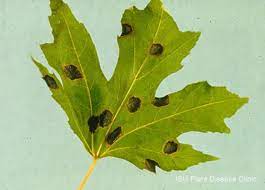 By Lyn Chimera One of the things I do as a Master Gardener is man the Hotline to answer people’s gardening questions. In the past month we have had many calls about Maple leaves with black spots, maple leaves dropping early and people spotting the Killer Hornet. Here is some information on both issues. Tar spot on Maples. Info adapted from the Cornell fact sheet. WNY is experiencing an increase in tar spot this season. There are actually several different fungi in the genus Rhytisma that infect the leaves of maples and cause raised, black spots to form on upper leaf surfaces. (see photo) The diseases are called "tar spots" because their appearance so closely resemble droplets of tar on leaf surfaces. Tar spot alone is rarely serious enough to threaten the health of trees, but sometimes there can be so many spots that the tree becomes unsightly. Heavy infections can also cause early leaf drop, a condition that causes homeowners to have to rake before autumn officially arrives. Norway maples are not native and brought the fungus with them when they came from Norway. It is a common street tree because it can withstand the stress of growing in less than optimum conditions. Norway maples are not the only trees affected by the fungi in the genus Rhytisma. Tar spot also infects silver, sugar, and red maple as well as their relative, box elder. For more info on Tar Spot: http://plantclinic.cornell.edu/factsheets/tarspotofmaple.pdf The best way to control is to rake up and remove all infected leaves. Spraying of fungicide is not recommended since tar spot doesn’t severely harm trees and the fungal spores travel in the air. You would have to spray the whole neighborhood to make a difference. If you want to plant a tree it’s always best to choose a native that is suited to our area and your site. Note: If maple leaves crinkle and turn brown in June or July, another common disease of maple may be present. Refer to the Cornell fact sheet on Anthracnose of Trees and Shrubs for more information. plantclinic.cornell.edu/factsheets/anthracnoseoftrees.pdf 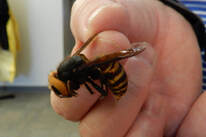 The Asian Giant Hornet (Vespa mandarinia) is another question we’ve been hearing a lot about. The name you’ve heard on the news is Murder Hornet. Just the name makes one worry. The Asian giant hornet is the world’s largest hornet at 2 inches long! (see photo). It was initially spotted in British Columbia and Washington state in 2019. The nests found were destroyed. This hornet is problematic because it attacks and destroys honeybee hives and is aggressive toward people. Because the Asian Giant Hornet looks similar to some large hornet and wasp species here, we are getting many calls of sightings of the “murder hornet”. None have been confirmed. Two of the most common insects people see here that they think are the Asian giant hornet are The German yellowjacket (Vespula germanica) and the European Giant Hornet (Vespa crabro L.) The yellowjacket is colored in black and yellow and the abdomen typically has a small spade-shaped black mark on the first abdominal segment and a series of black spots down both sides from the second to the fifth segments. The adult European hornet worker is approximately 1 inch in length with yellow and brown coloration. Sharon Bachman, the Invasive Species person at the Cooperative Extension, explained the visual difference between the Asian giant hornet and others. The yellow and black bands on the AGH are solid stripes while the other large species have irregular stripes with “crown like” protrusions. Bottom line is the Asian giant hornet has not been identified outside the northwest so you don’t have to worry. The Hotline is a free service to those living in Erie County. If you have a garden related question, need a soil pH test, insect, or disease identification you can call 716-652-2432 ext. 137, Monday, Wednesday, and Friday from 9-12. Due to Covid the offices are closed so your call will not be answered directly. Leave a message and a Master Gardener volunteer will get back to you during those hours. Some volunteers are working from home and others are at Cornell Cooperative Extension 21 S. Grove St. on the first floor. Happy Gardening! - - - - - - - - - - - - - - - - - - - - - - - - - - - - - - - Now is the best time to plan for improvements &/or changes for next year. Give us a call!
Back to Blog
Reducing Lawn9/1/2021 By: Lyn Chimera
Whether you live in the city, suburbs or in a rural area, lawns are a big part of the landscape. People have treated lawns as a status symbol for centuries. The movement began in Europe where having a manicured lawn was only available to the wealthy who could afford the workforce to keep it looking good. Unfortunately having that perfectly manicured lawn is still a status symbol for many people. They want their lawn to look like a golf course. Anyone who has tried to have that perfect lawn realizes what a lot of work it is to keep it that way. Not only is it time consuming but costly as well. There’s the lawn mower which needs gas and yearly maintenance, fertilizers, pesticides and herbicides which are not only tough on the pocketbook but very hard on the environment Let’s look at a few facts. Lawns across America use about 9 BILLION gallons of water a DAY! That’s the main reason during the drought out west watering lawns has been banned. The EPA reports that 50% of that water is wasted through evaporation and run off. According to 1971 NASA report lawns take up 3 times as much space as the next irrigated crop, corn. On top of that around 90 million pounds of fertilizers and about 75 million pounds of pesticides are used per year. Just why do we have all this lawn? What do we actually use it for? Some turf is productive like athletic fields, golf courses and recreational areas. We have to ask ourselves if this is the best use of our landscape space. There has been much written about habitat loss and the reduction of much needed pollinators, birds and other forms of life. Lawn doesn’t support any of that. Nature needs our help and that’s why so many people are reducing their lawn and developing more sustainable landscaping. This movement has been dubbed “unlawning”. There are many ways to reduce your lawn and have that space contribute to nature. One of the fastest growing ways to reduce lawn is to grow vegetables, fruit trees and berries. Many people have vegetable gardens in their back yards, but front yard gardens are gaining in popularity. Often the front or side yard is the only place that has enough sun to support growing food crops. Growing some of your own food not only enables your garden to be productive for nature but provides your family with fresh pesticide free fruits and vegetables. Fruits and vegetables need pollinators so you’re supporting nature. There are many ways to incorporate food crops; raised beds, in ground garden, containers or interspersed among your perennials. Meanwhile you won’t have so much lawn to take care of. Another option for unlawning is to transform some of the lawn space to meadow or pollinator gardens. This doesn’t mean you have to have an unkept field in your front yard. A section of lawn could be parceled out to be a pollinator garden/meadow. These sections could be shaped and mowed around to make it look more purposeful. The same effect can happen with wide mowed paths through the area. Organizing like species of plants rather than a general mixture also makes the meadow look more organized and like a garden if that is the look you prefer. Using native plants that support nature are the most effective plants to replace some lawn. They are beautiful and are the easiest way homeowners can help support nature and be sustainable. For ideas on how this might look check out: https://unlawningamerica.societyrne.net/unlawning-strategies.html I’m not trying to suggest everyone eliminate their lawns. Rather rethink areas that you don’t use that might be more sustainable for your families and nature. If you don’t want to reduce the amount of lawn, at least consider not using chemical fertilizers and pesticides. Lawns will do just fine without them. Also you don’t have to water the lawn. Grasses naturally go dormant when it’s dry. They will green up with the first rain. Happy Gardening! |

 RSS Feed
RSS Feed
